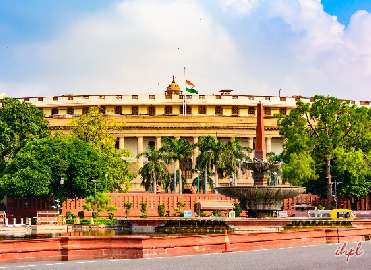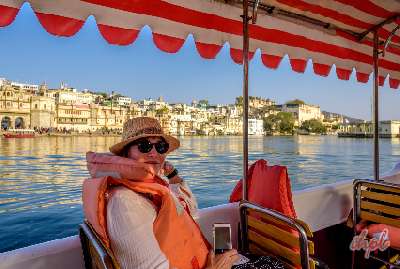Like many other landmarks of Delhi and her adjoining areas, Chandni Chowk too owes its origin to the Mughal rulers. The foundation stone for this vibrant bazaar was laid by Jahanara, Shah Jahan's favorite daughter. Today, the largest trading center of northern India, it is also known as the Moonlit Square. Situated in the Red Fort, the erstwhile capital of the Mughal dynasty, Chandni Chowk is characterized by its many lanes and by-lanes that are filled with all the hustle and bustle associated with vibrant market places. Each of these lanes is famous for a specialty that is particular to itself. These can range from glittering jewelry to mouthwatering foodstuff.
Chandni Chowk is famous not just for its markets but also for the various places of worship that the region has. These include:
- Sri Digambar Jain lal Mandir
- Jama Masjid
- Gurudwara Shish Ganj
- Gauri Shankar Temple
- Sunehri Masjid
Chandni Chowk perhaps symbolizes the vibrant feel that characterizes India and her way of life. Besides this, it also symbolizes the unity in diversity that is present amongst Indians all around the country. It is, on a lighter note also a symbol of the versatile eating habits of the Indians, housing eateries like:
- The Ghantewala Halwai
- Natraj's Dahi Bhalle
- Kanwarji Bhagirathmal Dalbhajiwallah
- Chaatwallah
- Bikaner Sweet Shop
- Haldiram's
- Gianiji ka Falooda
History:
Symbolizing the remnants of a medieval world, the Chandni Chowk today stands at crossroads in time, looking forward to an age where modernity and tradition promise to walk hand in hand. The history of Chandni Chowk dates back to the foundation of the city of Shahjahanabad when the Mughal emperor, Shah Jahan established the Red Fort or the Laal Quila as it is also known on the banks of the River Yamuna beside his newly founded capital city of Shahjahanabad.
Chandni Chowk or the Moonlight Square was designed and established by Princess Jahanara, Shahjahan’s favorite daughter in 1650 A.D. The bazaar which was shaped as a square was given a further dash of elegance by the presence of a pool in the center of the complex which shimmered in the moonlight, a feature which was perhaps responsible for the nomenclature of the marketplace. The shops of the complex were originally built in a half-moon shape, a pattern, which, however, is lost today. The bazaar was in the time of Shahjahan was famous for its silver merchants, which could also have an important role to play in the nomenclature of the Chandni Chowk as silver is referred to as Chandi in Hindi, a word which could have been slightly deformed to form Chandni Chowk.
Annual Events:
The appeal of Chandni Chowk is not restricted to her importance as the largest trading center in northern India alone. This medieval marketplace is a part of Indian history and a witness to many of the epoch making events in the history of India. Even today, the market echoes with images of a past, where glorious processions set out to celebrate the coronation of the Mughal emperors or to mark royal weddings with all the pomp and finery that the occasions demanded. The sounds of the light swirl of the skirts of the princesses as they shopped for exquisite jewelry and the rustle of silk of the fabrics on display are still entrapped in each and every stone that surround the cobbled pathways of this medieval marketplace. Even today, the entire ambience of the marketplace is alive to the sounds, sights and events that surround the daily lives of the Indians and a reflection of this can be found in the annual events of Chandni Chowk.
These include, the Republic Day Parade on 26th January, when Indians irrespective of their religion, age or caste throng the area to celebrate the foundation day of the world’s largest republic. Besides this, the area also celebrates a number of other religious occasions which include Diwali, Dussehra, Id-ul-fitr, Sikh, Jain and Christian festivals.
Fast - Facts:
Location
Located on Netaji Subhash Marg, Old Delhi, Chandni Chowk is located close to a number of other tourist attractions of Delhi and just opposite the Lahori Gate of the Red Fort.
Built by
Designed by Princess Jahanara, Shah Jahan’s favorite daughter, Chandni Chowk was built in 1650 A.D.
Nature & Architectural style
Chandni Chowk was originally shaped as a square with a pool in the middle of the complex. The shops were organized in a half-moon pattern.
Timings
Chandni Chowk is open everyday from 10 a.m. to 4 p.m. though it is advisable to avoid Sundays.
Admission charges
Entry to the Bazaar is free.
How To Reach:
Located in the heart of the city of Old Delhi, reaching Chandni Chowk can be easily accomplished as it is well-connected by:
- Nearest airport Indira Gandhi International Airport
- Nearest railway station Old Delhi Railway Station
- Nearest metro station Kashmir Gate
Nearby Attractions:
Noted for its medieval structure as well as for the sheer artistry of the exquisite jewelry and fine embroidery, the market place at Chandni Chowk is more than just an important tourist attraction of Delhi. Adding further importance to the landmark are the various nearby attractions of the Chandni Chowk. These include:
Red Fort
One of the most important symbols of India’s sovereign democracy, the Red Fort was once the capital of the Mughal dynasty after it was built by Shahjahan as his capital called Shahjahanabad. A huge complex showcasing life as it was in during the Golden Rule of the Mughals, the Red Fort is a must-visit while on a trip to Delhi.
Qutub Minar
Another important symbol of the historic city of Delhi, the Qutub Minar is an iron tower built in 1199 by Qutubuddin Aibak, which has till today, not shown a single speck of rust.
Jama Masjid
One of the most respected shrines of India as well as the country’s oldest mosque, the Jama Masjid is regarded as a sacred place for worship not just amongst Muslim but also among their non-Muslim counterparts.
India Gate
Built as a memorial for the Indian soldiers who were killed in the 1st World War, the India Gate is an imposing structure that arches to give a glimpse of the red sandstone structure of the Red Fort.
Besides these, Chandni Chowk is also home to a number of roadside eateries which include the Ghantewala Halwai, Natraj's Dahi Bhalle, Kanwarji Bhagirathmal Dalbhajiwallah, Bikaner Sweet Shop, Chaatwallah, Gianiji ka falooda, Karim Hotel, food stalls near Jama Masjid, Paranthewali gali, Natraj hotel, Chor Bizarre of Broadway Hotel, Daryaganj's Flora, Peshwari and the Moti Mahal Restaurant.
















